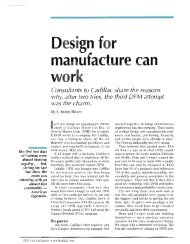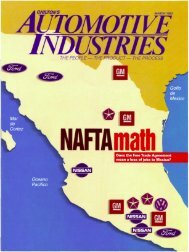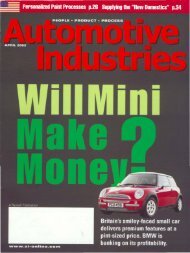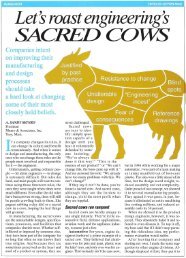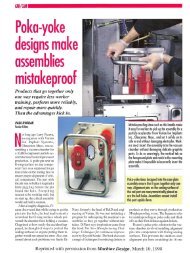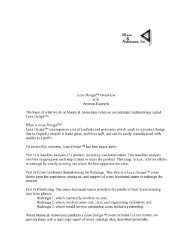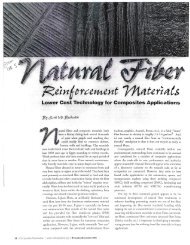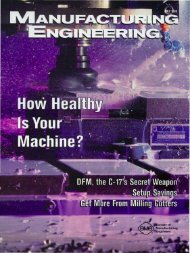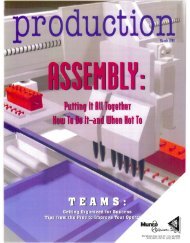Sandy Munro - Mining for Gold with Lean Design in Aircraft Interiors
Sandy Munro - Mining for Gold with Lean Design in Aircraft Interiors
Sandy Munro - Mining for Gold with Lean Design in Aircraft Interiors
You also want an ePaper? Increase the reach of your titles
YUMPU automatically turns print PDFs into web optimized ePapers that Google loves.
At <strong>Munro</strong> & Associates, we don’t make products, but we do make them more profitable.<br />
Consider these Team<strong>Munro</strong> success stories. Here are a few:<br />
- Consolidated parts <strong>in</strong> a console assembly, reduced the number of parts by 33%, the build<br />
time by 40%, and the piece cost by 12%.<br />
- Reduced the overall cost of a Lavatory by 50% plus added extra features.<br />
- On an exhaust system improved the customer satisfaction <strong>in</strong>dex by 30X and reduced the<br />
total cost by 80%<br />
- Redesigned an accelerator pedal and reduced the number of parts from seven and one,<br />
generated an estimated 70% cost sav<strong>in</strong>gs and elim<strong>in</strong>ated 100% of the assembly labor.<br />
If you have the burn<strong>in</strong>g need to <strong>in</strong>crease Quality and profitability, you need Team<strong>Munro</strong>.<br />
The <strong>Lean</strong> <strong>Design</strong> Process – The Four T’s<br />
Tim<strong>in</strong>g: Do It Right The First Time:<br />
The key to big success is tim<strong>in</strong>g. While <strong>in</strong> the concept stage, OEM’s are experiment<strong>in</strong>g <strong>with</strong><br />
designs; designs, which can create a life sentence of satisfaction or great frustration on the<br />
factory floor. <strong>Design</strong> is the most critical step and the driv<strong>in</strong>g <strong>for</strong>ce <strong>in</strong> the manufactur<strong>in</strong>g<br />
process. The proof is <strong>in</strong> the analyses of the product’s total manufactur<strong>in</strong>g cost, illustrated <strong>in</strong><br />
Diagram (1). Product design may only account <strong>for</strong> five percent of a product’s total cost, but<br />
it dictates 75 percent of the product’s total manufactur<strong>in</strong>g cost. There<strong>for</strong>e, it becomes critical<br />
that designs are done right, the first time. While <strong>in</strong> the concept stage, designs can be modified<br />
easily <strong>with</strong> a stroke of a pen and few mouse clicks. Changes are rapid and relatively<br />
<strong>in</strong>expensive. If additional changes are needed after the design is complete, one must consider<br />
all of the downstream activities, which may be affected, such as per<strong>for</strong>mance test<strong>in</strong>g,<br />
assembly and check<strong>in</strong>g fixtures, secondary tools and production tool<strong>in</strong>g. As seen <strong>in</strong> Diagram<br />
(2) as the product time l<strong>in</strong>e progresses the cost to implement changes rises exponentially. To<br />
summarize, though it is never too late to do what is right, the later the change, the more<br />
expensive the correction.<br />
Influence On Total Manufactur<strong>in</strong>g Cost<br />
Cost of Product Changes<br />
2




